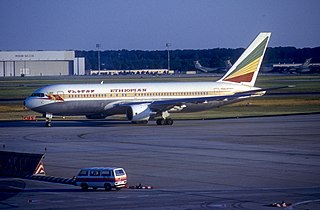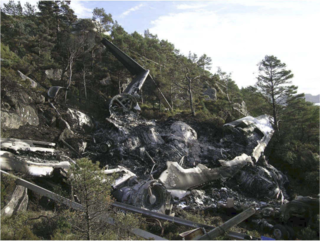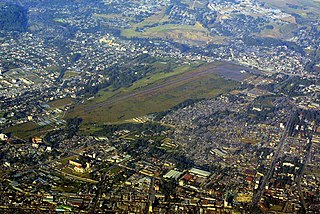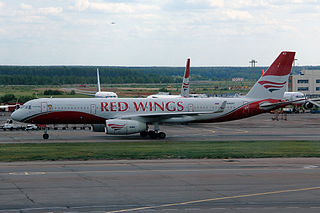
The Vickers VC10 is a mid-sized, narrow-body long-range British jet airliner designed and built by Vickers-Armstrongs (Aircraft) Ltd and first flown at Brooklands, Surrey, in 1962. The VC10 is often compared to the larger Soviet Ilyushin Il-62, the two types being the only airliners to use a rear-engined quad layout, while the smaller business jet Lockheed JetStar also has this engine arrangement.

Ethiopian Airlines Flight 961 was a scheduled international flight serving the route Addis Ababa–Nairobi–Brazzaville–Lagos–Abidjan. On 23 November 1996, the aircraft serving the flight, a Boeing 767-200ER, was hijacked en route from Addis Ababa to Nairobi by three Ethiopians seeking asylum in Australia. The plane crash-landed in the Indian Ocean near Grande Comore, Comoros Islands, due to fuel exhaustion; 125 of the 175 passengers and crew on board, including the three hijackers, died. This is the first recorded instance of a partially successful ditching utilizing a wide-body aircraft.

Addis Ababa Bole International Airport is an international airport in Addis Ababa, Ethiopia. It is in the Bole district, 6 km (3.7 mi) southeast of the city centre and 65 km (40 mi) north of Bishoftu. The airport was formerly known as Haile Selassie I International Airport. It is the main hub of Ethiopian Airlines, the national airline that serves destinations in Ethiopia and throughout the African continent, as well as connections to Asia, Europe, North America and South America. The airport is also the base of the Ethiopian Aviation Academy. As of June 2018, nearly 380 flights per day were using the airport.

Swissair Flight 306, a Sud Aviation SE-210 Caravelle III, named Schaffhausen, was a scheduled international flight from Zürich to Rome, via Geneva. It crashed near Dürrenäsch, Aargau, on 4 September 1963, shortly after take-off, killing all 80 people on board.

Maya–Maya Airport is the international airport of Brazzaville, the capital of the Republic of Congo.

Atlantic Airways Flight 670 was a crash following a runway overrun of a British Aerospace 146-200A at 07:32 on 10 October 2006 at Stord Airport, Sørstokken, Norway. The aircraft's spoilers failed to deploy, causing inefficient braking. The Atlantic Airways aircraft fell down the steep cliff at the end of the runway at slow speed and burst into flames, killing four of sixteen people on board.
Wadi Halfa Airport is an airport serving Wadi Halfa in Sudan. The airport is approximately 14 kilometres (8.7 mi) east of Wadi Halfa.

Spantax Flight 995 was a charter flight from Madrid-Barajas Airport to New York via Málaga Airport on September 13, 1982. When the DC-10 aircraft was rolling for take-off from Malaga, the pilot felt a strong and worsening vibration and aborted the take-off. The flight crew lost control of the aircraft and were unable to stop in the runway available and the aircraft overran the runway, hit an airfield aerial installation, losing an engine, then crossed the Malaga–Torremolinos Highway, hitting a number of vehicles before finally hitting a railway embankment and bursting into flames. An emergency evacuation of the aircraft was carried out but 50 on board died of both burns and other injuries. A further 110 people were hospitalized.

BOAC Flight 712 was a British Overseas Airways Corporation (BOAC) service operated by a Boeing 707-465 from London Heathrow Airport bound for Sydney via Zurich and Singapore. On Monday 8 April 1968, it suffered an engine failure on takeoff that quickly led to a major fire; the engine detached from the aircraft in flight. After the aircraft had made a successful emergency landing, confusion over checklists and distractions from the presence of a check pilot contributed to the deaths of five of the 127 on board. The direct cause of the fire was the failure of a compressor wheel, due to metal fatigue.
Air France has been in operation since 1933. Its aircraft have been involved in a number of major accidents and incidents. The deadliest accident of the airline occurred on June 1, 2009, when Air France Flight 447, an Airbus A330-203, flying from Rio de Janeiro to Paris crashed into the Atlantic Ocean with 228 fatalities. A selected list of the most noteworthy of these events is given below.

Ethiopian Airlines Flight 604 was a scheduled Addis Ababa–Bahir Dar–Asmara flight in which the aircraft caught fire during a belly landing at Bahir Dar Airport, Bahir Dar, Ethiopia, on 15 September 1988.

The 1950 Heathrow BEA Vickers Viking crash occurred on 31 October 1950 when a Vickers Viking operated by British European Airways (BEA) crashed at London Airport in heavy fog. The aircraft was on a scheduled flight between Paris and London's Northolt airport and 28 of the 30 passengers and crew on board were killed.

Lideta Airport also colloquially known as the Old Airport is a decommissioned military airport located in Addis Ababa, Ethiopia.

On 20 November 1969, Nigeria Airways Flight 825, a Vickers VC10 aircraft, crashed while on approach to Lagos International Airport in Lagos, Nigeria killing all 87 people on board.

Red Wings Airlines Flight 9268 was a Tupolev Tu-204-100 passenger jet that on 29 December 2012 crashed on landing at Moscow Vnukovo Airport, Russia, following a repositioning flight from Pardubice Airport, Czech Republic. There were no passengers on board, but 5 of the 8 crew members were killed when the aircraft hit a ditch and highway structures after overrunning the runway.

Delta Air Lines Flight 1086 was a scheduled Delta Air Lines domestic passenger flight between Atlanta and New York's LaGuardia Airport. On March 5, 2015, the McDonnell Douglas MD-88 aircraft veered off the runway shortly after landing at LaGuardia Airport in New York City. The plane ran up the seawall berm and struck the perimeter fence, sliding along it for approximately 940 feet (290 m) before coming to rest with the nose of the aircraft hanging over the berm above Flushing Bay. There were no fatalities, although 29 people suffered minor injuries. The aircraft was seriously damaged and written off.

Propair Flight 420 (PRO420) was a domestic charter flight from Montreal, Quebec to Peterborough, Ontario. The flight was carried out by Propair, a charter airline based in Rouyn-Noranda, Quebec, using a Fairchild Metroliner SA226. On 18 June 1998, the aircraft suffered an in-flight fire shortly after take-off from Dorval and the crew elected to conduct an emergency landing at Montréal–Mirabel International Airport. The intense heat of the fire caused a structural failure in the left wing during the landing and the aircraft crashed, resulting in the deaths of all 11 passengers and crew on board.















